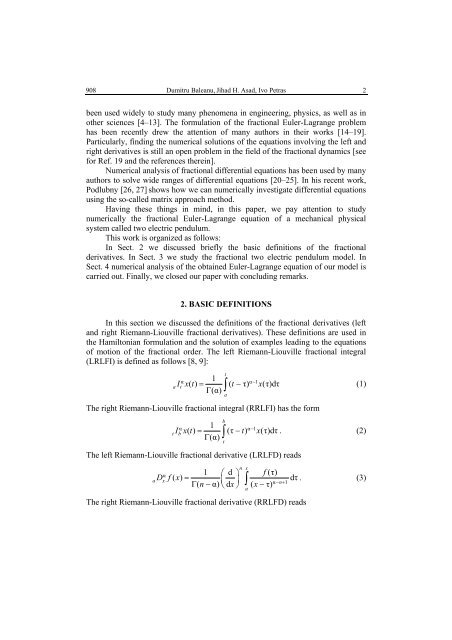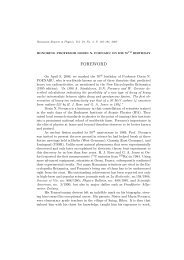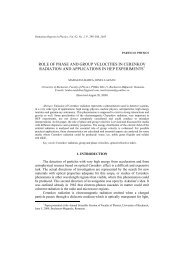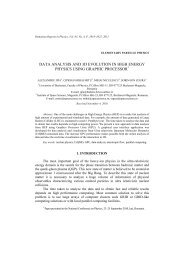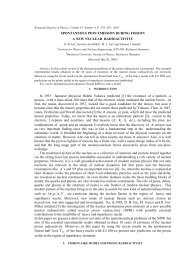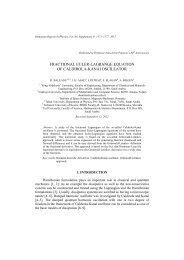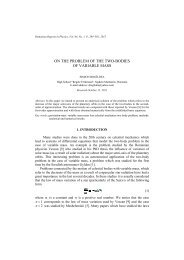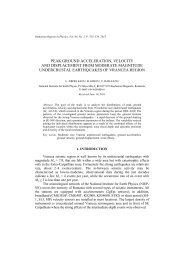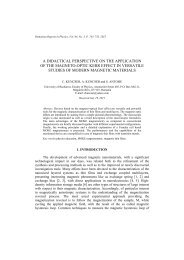View - Romanian Reports in Physics
View - Romanian Reports in Physics
View - Romanian Reports in Physics
You also want an ePaper? Increase the reach of your titles
YUMPU automatically turns print PDFs into web optimized ePapers that Google loves.
908<br />
Dumitru Baleanu, Jihad H. Asad, Ivo Petras<br />
2<br />
been used widely to study many phenomena <strong>in</strong> eng<strong>in</strong>eer<strong>in</strong>g, physics, as well as <strong>in</strong><br />
other sciences [4–13]. The formulation of the fractional Euler-Lagrange problem<br />
has been recently drew the attention of many authors <strong>in</strong> their works [14–19].<br />
Particularly, f<strong>in</strong>d<strong>in</strong>g the numerical solutions of the equations <strong>in</strong>volv<strong>in</strong>g the left and<br />
right derivatives is still an open problem <strong>in</strong> the field of the fractional dynamics [see<br />
for Ref. 19 and the references there<strong>in</strong>].<br />
Numerical analysis of fractional differential equations has been used by many<br />
authors to solve wide ranges of differential equations [20–25]. In his recent work,<br />
Podlubny [26, 27] shows how we can numerically <strong>in</strong>vestigate differential equations<br />
us<strong>in</strong>g the so-called matrix approach method.<br />
Hav<strong>in</strong>g these th<strong>in</strong>gs <strong>in</strong> m<strong>in</strong>d, <strong>in</strong> this paper, we pay attention to study<br />
numerically the fractional Euler-Lagrange equation of a mechanical physical<br />
system called two electric pendulum.<br />
This work is organized as follows:<br />
In Sect. 2 we discussed briefly the basic def<strong>in</strong>itions of the fractional<br />
derivatives. In Sect. 3 we study the fractional two electric pendulum model. In<br />
Sect. 4 numerical analysis of the obta<strong>in</strong>ed Euler-Lagrange equation of our model is<br />
carried out. F<strong>in</strong>ally, we closed our paper with conclud<strong>in</strong>g remarks.<br />
2. BASIC DEFINITIONS<br />
In this section we discussed the def<strong>in</strong>itions of the fractional derivatives (left<br />
and right Riemann-Liouville fractional derivatives). These def<strong>in</strong>itions are used <strong>in</strong><br />
the Hamiltonian formulation and the solution of examples lead<strong>in</strong>g to the equations<br />
of motion of the fractional order. The left Riemann-Liouville fractional <strong>in</strong>tegral<br />
(LRLFI) is def<strong>in</strong>ed as follows [8, 9]:<br />
t<br />
α<br />
1<br />
α−1<br />
a t<br />
= −<br />
(α)<br />
a<br />
I x() t ( t τ) x(τ)dτ<br />
Γ ∫<br />
(1)<br />
The right Riemann-Liouville fractional <strong>in</strong>tegral (RRLFI) has the form<br />
b<br />
α<br />
1<br />
α−1<br />
t b<br />
= −<br />
(α)<br />
t<br />
I x() t (τ t) x(τ)dτ<br />
Γ ∫<br />
. (2)<br />
The left Riemann-Liouville fractional derivative (LRLFD) reads<br />
n x<br />
α<br />
1 ⎛ d ⎞ f (τ)<br />
aDx f x =<br />
α− n+<br />
1<br />
Γ( n−α) ⎜<br />
d x<br />
⎟<br />
( x−τ)<br />
a<br />
( ) ∫ dτ. (3)<br />
⎝ ⎠<br />
The right Riemann-Liouville fractional derivative (RRLFD) reads


